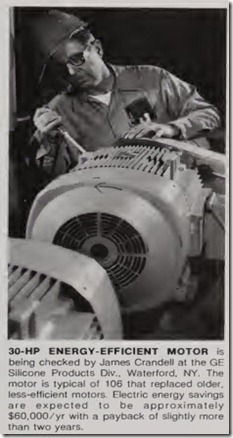Motor retrofits to save over $2-million
TWO UPSTATE New York industrial plants recently invested nearly $1/2-mil lion in energy-efficient motors, replac ing 286 “standard” motors in a pro gram expected to save almost $2- million in the next decade.
One facility was the General Electric Silicone Products plant, Waterford, NY, which purchased 106 energy-effi cient motors; the other was the GE Noryl plant in Selkirk, NY, which pur chased 180 units.
Both plants are chemical/process production plants that run continuous ly, or approximately 7000 hrs/yrs, wh ich is a major factor in developing the cost justification for converting to the energy-efficient motors. At both plants, 80 to 90% of the power used is consumed by motors. Motors selected for retrofit ranged in size from 7lf2 to 250 hp and drive pumps, fans, compres sors, and certain process machines.
Management at both facilities has been aware of the benefits of energy conservation since the mid ’70s. Old outdated lighting systems have been replaced with new, efficient, high-pres sure-sodium lighting. Boiler systems have been modernized, HV AC system operations has been made more effi cient, and total energy management using microprocessor-based equipment is under consideration.
After seeing the dollar savings obtained from the initial electric ener gy-saving measures, management at both plants looked closely at their larg est electric power consumers-their motors. At first, energy-efficient mo tors were specified as the required drive on newly purchased machines or plant equipment. Next, the energy-effi cient motors were purchased as re placements for most failed motors. After actual field operation proved that significant savings were obtained, programs at both plants were launched to retrofit appropriate motors.
At the Waterford plant, the entire population of 1500 motors was sur veyed, listing size, hours of operation, application, and priority of the process involved. Priority was important be cause plant electrical people, who are responsible for electrical maintenance at these continuous-process plants, called for maximum reliability of motors. In addition to running effi ciently, these motors are highly reli able. Because they have better steel, improved characteristics in the stator and rotor, and extra copper in the windings, they operate at temperatures 20° to 30° C cooler than conventional
motors. As a result, insulation and bearing lubricant life is increased, meaning reduced maintenance and downtime, which is particularly expen sive at these continuous-operation plants.
Of the 1500 motors at the Waterford plant, 106 met all the retrofit require ments. This included a payback period of about two years. At the local pur chased power cost of about $.06/kWh, plant management expects to save nearly $60,000 on electric energy bills in the energy-efficient motor’s first year of operation. This results in a payback period of slightly more than 2 years. Assuming a steady 10 to 15% rise in the electric energy rates, sav ings will total approximately $640,000 after 7 years.
At the Selkirk plant, over 3000 motors were audited. Approximately 300 were considered to meet initial criteria; however after careful analysis based on size, rating, application, and operating mode, 180 motors were selected to be replaced with new ener gy-efficient motors. Most chosen run at 7200 hrs/yr; others that run for less time were selected because of their advanced age and increased mainte nance risk. These motors were the most obvious candidates for retrofit. They offer the quickest payback with the least disturbance of on-going facto ry operations. Later, additional motors will be changed out as they also fit the requirements of a retrofit program , which includes ease and speed of changeout, payback time, and nonin terference with overall plant opera tion.
Purchased power at this location is also $.06/kWh, which will result in a savings of more than $100,000 in power costs the first year. With a projected 10.5% annual power cost increase, sav ings will total approximately $2 million after a decade. Payback is expected in just under three years.
